Three Ways to Prune Rhododendrons
Here’s how to maintain, shape, or rejuvenate rhododendrons
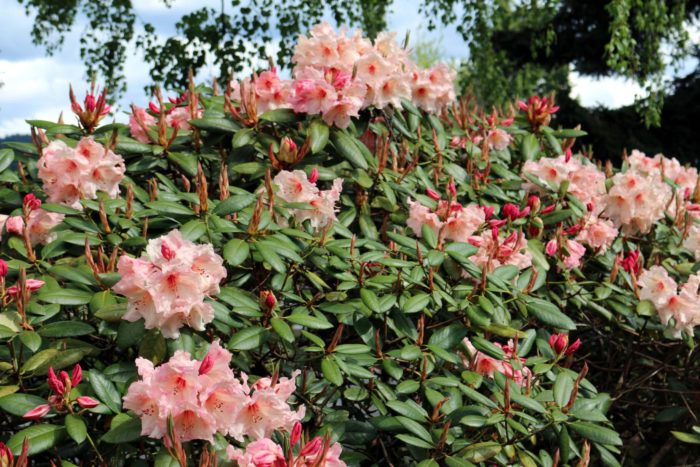
I learned to prune rhododendrons by destroying my prized rock garden. I had a 30-foot-tall pine that I needed to cut down. It missed the house by a wide margin, but it didn’t miss the rock garden, which I had lovingly tended for years.
When the last of the pine tree was removed, I discovered that the damage was surprisingly slight, except for a beautiful Rhododendron ‘Roseum Elegans’, now a 2-foot mound of broken branches and torn foliage. Curious to see if the shrub would recover on its own, I trimmed it back a bit, cut back the scaffold of branches to as pleasing a shape as possible, and waited to see what would happen. Four years later, the rhododendron is one of the most eye-catching shrubs in the yard, with a beautiful shape, dense branches, and plentiful flowers. The incident illustrates how responsive rhododendrons can be to even severe pruning.
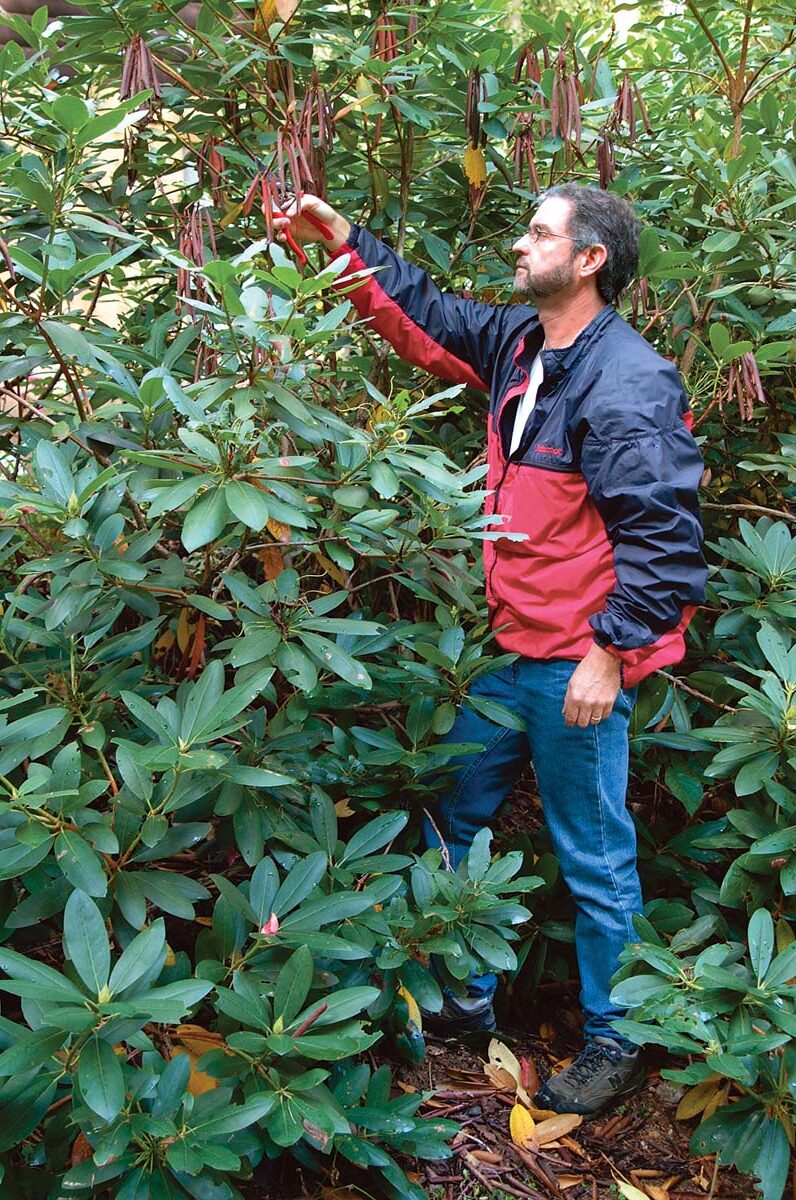
There are three common reasons for pruning rhododendrons—maintenance, shaping, and rejuvenation—and the pruning method for each is easy to learn. The result is a shrub with dense branching, plentiful foliage, and abundant flowers. And you don’t have to drop a pine tree on your shrub border to learn how to do it.
Method 1: Maintenance pruning removes old flowers and dead wood
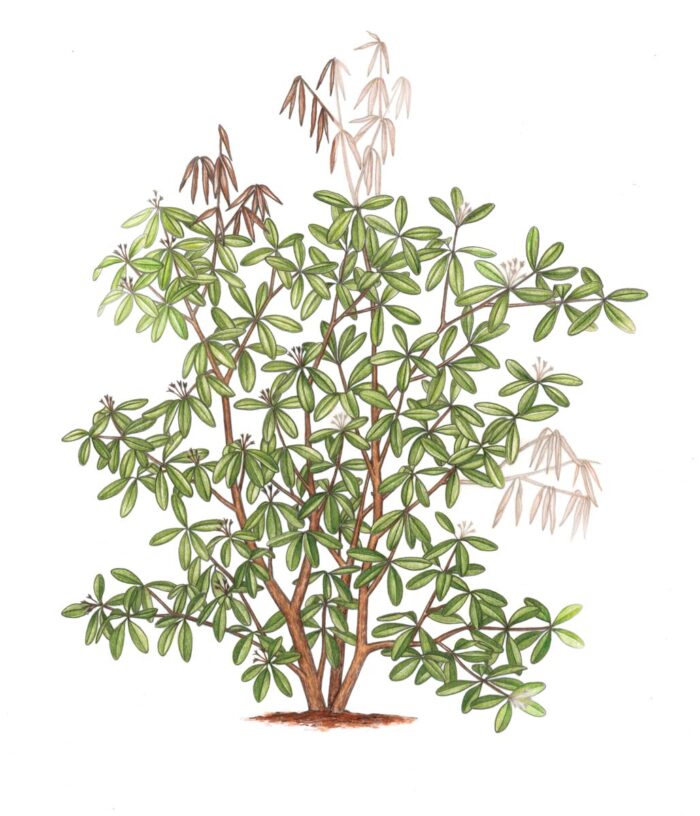
Maintenance pruning consists of the removal of spent flower clusters, called trusses, and also of any dead or diseased wood. The trusses are not only unsightly but will eventually form seed, which uses precious energy that would otherwise be available to the plant for vegetative growth. Maintenance pruning is the easiest type of pruning and is the only one that needs to be done every year.
To remove old flower trusses on rhododendrons, use a pruning shear to snip the truss at its base, about ½ inch above the emerging flush of new growth. Some folks just grasp the stem with their thumb and forefinger and snap the truss from the plant. This works well most of the time, but occasionally the truss breaks off, taking some of the new growth with it. By using a pruning shear, such accidents are avoided.
 |
Maintain your rhododendron by snipping off spent flower clusters (trusses) . . . |
 |
. . . and by removing dead and diseased wood. |
Wood damaged by storms or a harsh winter should be clipped from the plant. Diseased stems, often identified by their wilted, curled yellow-green leaves, should also be removed. Make the cut below the damaged portion of the plant, taking care to cut into healthy wood right above a dormant bud. Be sure to disinfect the shears with rubbing alcohol between cuts.
Maintenance pruning is best done when the flowers have faded and before the flush of new growth rising beneath each truss is more than an inch or so tall. Many types of rhododendrons can benefit from maintenance pruning, including some deciduous azaleas, like the Knap Hill-Exbury hybrids, and most broad-leaved evergreens, such as the popular hybrids of mountain rosebay (R. catawbiense). Some varieties of rhododendron, most notably small-leaved cultivars like ‘Elite’, ‘Northern Starburst’, and ‘PJM Regal’, rarely set seed and do not require maintenance pruning. If your flowers and flower stalks simply shrivel up and essentially disappear in the weeks after flowering, then your variety doesn’t set seed and doesn’t need to be deadheaded.
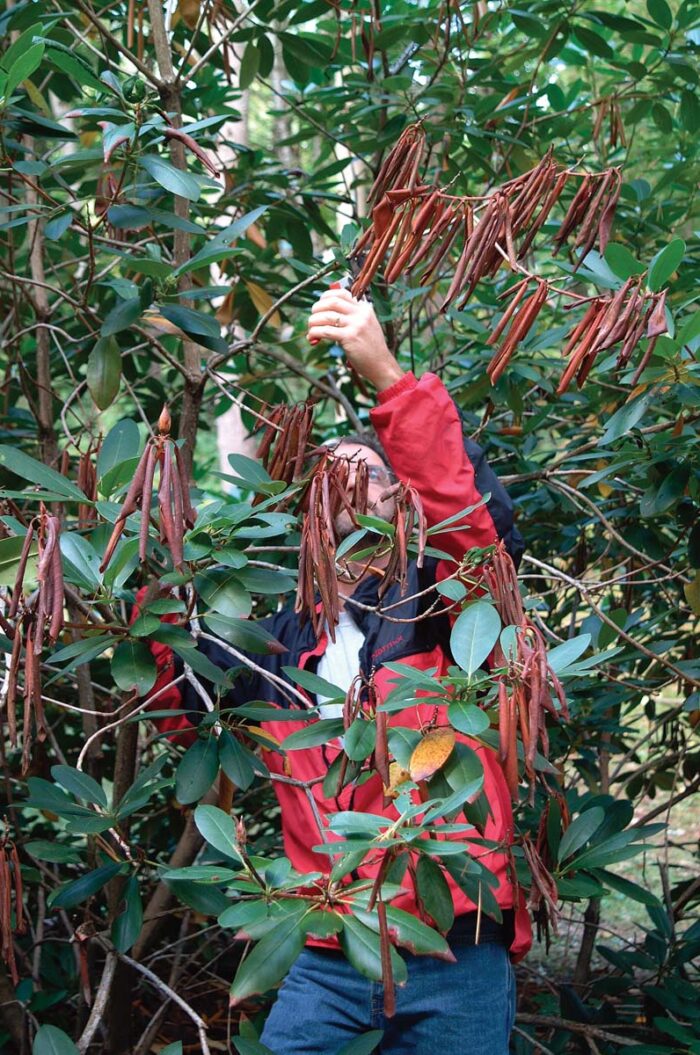
Method 2: Pruning for shape enhances the plant’s natural habit and form
Conversely, topiary and other more formal shaping techniques prune a plant into a shape it would not naturally assume. Shaping should not be done on leggy or very large plants, as their open habit requires a more drastic technique called rejuvenation pruning.As the name implies, shaping involves altering the shape of the plant, and it can be done for many reasons, from encouraging denser branching to controlling plant width or height. It differs from other shaping techniques, like topiary, in that shaping of rhododendrons is designed to develop the most aesthetically pleasing aspects of the plant’s natural habit and form.
Shaping improves the appearance of a plant by encouraging increased branching at its growing points. Since many evergreen rhododendrons hold their leaves for about three years, a branch will have a series of leaf whorls, each representing a year’s growth. The whorls of foliage are separated by sections of leafless stem, called internodes. In general, broad-leaved rhododendrons have much longer internodes than small-leaved and deciduous types and benefit most from shaping. To shape a rhododendron, follow the branch from the end down to the last whorl of leaves you want to keep. Make the cut about ¼ inch above the topmost leaf in this cluster. Repeat as needed.
Shaping is most easily done in late winter, while the plant is dormant. Although this sacrifices some of the flower buds, it ensures a complete growing season for the new stems that emerge.
 |
To shape a rhododendron, follow the branch down to the last whorl of leaves you want to keep, and cut just above those leaves. |
 |
To shape, cut just above the whorl of leaves. |
Method 3: Rejuvenation pruning calls for drastic cuts on old wood
Rejuvenation pruning involves the careful cutting back of each primary branch of the plant’s framework. Rhododendrons often have three or more main branches rising from the crown of the plant. These branches, called primary branches, form the basic scaffold of each shrub. Each branch is cut at a different height to produce a staggered arrangement that will make the shrub look natural when the new shoots mature. Rejuvenation pruning is best used to restore shrubs that have become leggy, overgrown, or otherwise unattractive. Many rhododendron species and hybrids can be severely pruned and come back as good as new. Rejuvenation pruning removes most of the branches of the plant, initiating the rise of vigorous flushes of new growth from previously leafless old stems. The new growth matures into a new framework of branches that can then be shaped over the years to produce a stunning shrub. It’s best to perform this type of pruning in winter, while the plant is dormant.
Another type of rejuvenation pruning consists of cutting the entire plant to within 6 inches of the ground. It is a quick method, but not all rhododendrons survive the treatment. In some instances, an apparently healthy plant may be weakened by disease or poor nutrition and cannot recover from the stresses of hard pruning. To see if your shrub can handle such a hard pruning, cut only one of the main branches back to 6 inches. Cut the others back to a height you are sure is healthy, say 2 feet. If new growth emerges from the 6-inch cut, you can cut back the rest of the shrub the following year and be confident in its return.
Regardless of the method, rejuvenation pruning works because of a special trait of rhododendrons. Look at the bark on a stem or main branch of many rhododendrons and you will see tiny buds, little pink dots about the size of a pinhead that pepper the surface of older branches. These little pink buds, called latent buds, are the key to successful rejuvenation pruning, as they will give rise to the new framework of branches.
Once you’ve determined how far back the plant needs to be pruned, take a moment and examine the area for a nice healthy bud (one that is firm and appears filled out), and cut ½ to ¾ of an inch above that bud. Pruning above a cluster of two or three buds is better than pruning above just one bud, as this often produces multiple branches.
 |
Cut just above a latent bud to rejuvenate the shrub. |
All three of these pruning methods are easy to do and result in a healthier and more attractive shrub. Don’t worry about making mistakes. Rhododendrons are very forgiving—even if you drop a tree on them.
Fine Gardening Recommended Products

ARS Telescoping Long Reach Pruner
Fine Gardening receives a commission for items purchased through links on this site, including Amazon Associates and other affiliate advertising programs.

Fine Gardening receives a commission for items purchased through links on this site, including Amazon Associates and other affiliate advertising programs.
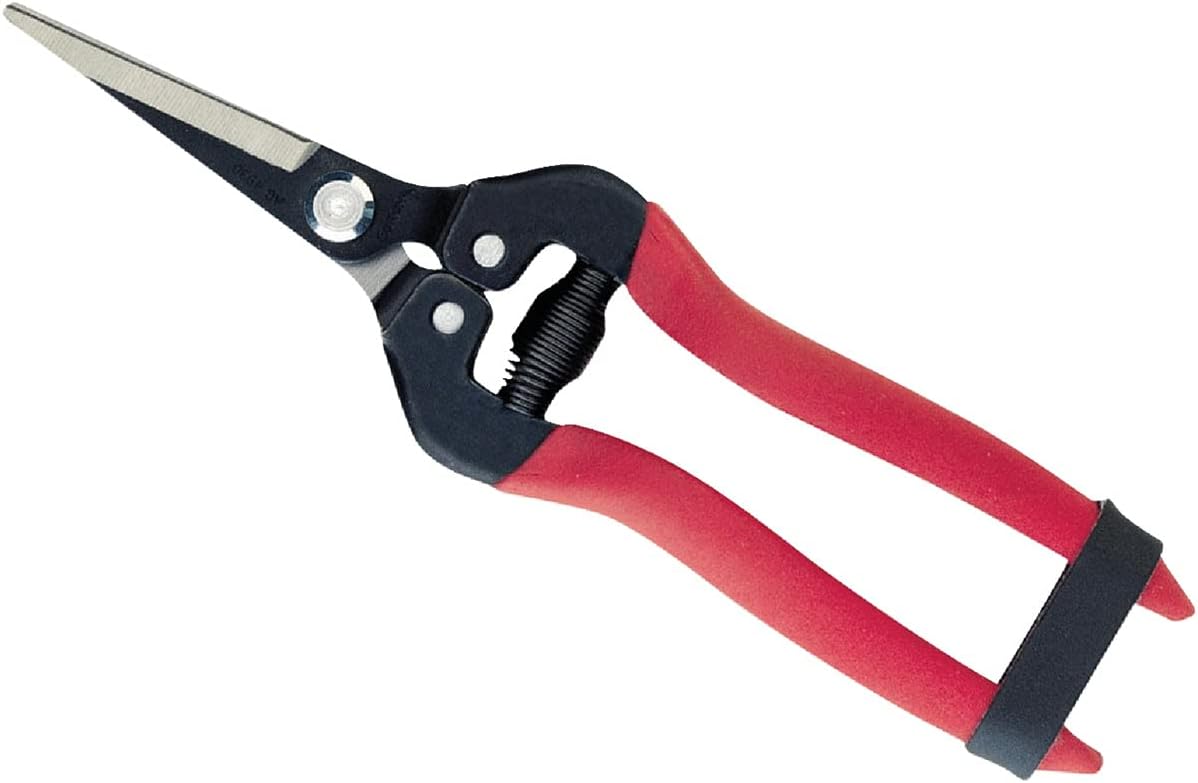
Corona AG 4930 Long Straight Snip, Tempered Steel
Fine Gardening receives a commission for items purchased through links on this site, including Amazon Associates and other affiliate advertising programs.







Comments
I want to keep my plants low, should I pinch back the new growth?
Thanks so much! I'm about to trim a neighbor's rhodies and I wanted to be sure that I did a good job, so I'll be sure to look out for some good candidates for maintenance pruning.
I have a rhododendron plant and it's growing outwards. Do I prune it but if I didn't would it grow tall. I've got mine in a pot but can't put it in the ground as its just all paved.
Rhodos need space, lots of space. Give it to someone who has more garden space :(
No way. I have had mine in a pot for about 15 years and it is now at a stage where it does need rejuvenatiing which I'll do this winter :)
I too like to keep my plants low since I have a small garden and I have 2 rhododendrons this year and trimming them as they grow. I am not sure if I am doing right but can't afford for them to overtake the garden because of the limited space. Hoping I will still get the beautiful small purple flowers that were when I purchased the plant this year.
Thanks for the great advice! I have at least ten rhodys growing around my house and they are starting to EAT my house right up! I was able to prune one down to about 5 ft, and it looks great. Another one I had to take down to about 2 ft, and it is just stumps... Wasn't able to save it at all because all the growth was in the front, and it was empty on the inside... Hoping I will see it come back!
How did the stumpy one turn out? I'm in the same boat with 4 of mine and wondering if I should cut way back.
I have around 8 mature Rhododendron bushes scattered around my garden that I want to move to create new screening. I intend to follow your advice on rejuvenation pruning but also want to dig out the root ball of the plant. Is this advisable?
Why do you want to dig out the root ball?
Rhododendrons are usually quite easy to move as the rootball is fairly shallow and will lift like a large mat. I don't think i would both seriously prune and move the plant(s) in the same season. Two shocks might not be conducive to happy plants.
So I finally got sick of all the rhodys and I had someone chainsaw em right down to the ground! Well, wouldn't you know... they are coming back! LOL! I now have landscape fabric over them and I am going to mulch right over it. Aye! Unbelievable how tough these guys are!
I did keep two, because I truly do love the way they look. But the ones that were "eating up my house" had to go!
when is the best time to take them down
anytime you want! ;)
@H David, what I've been doing for years is if your rhodos have more than one branch coming out of the ground, trim out 1/3 of the oldest (thickest) branches right at ground level. The shrub will send up new branches. Do this every year for 3 years and at the end of that time you will have an essentially new, more manageable sized rhodo. HTH
1977/'78 we (our family) built a beautiful house in 24 open acres ... lined the "yard" with rhododendrons ... 15 beds and some 500+plants later some towering around20 ' tall they respond well to a good invigorating Clean up of deadwood and deadheads.
... im finding it very fun!
I have Rhododendrons laying on the ground. They are beautiful but I'm worried I should prune them back. There are about 15 -20 of them if they stood upright they would be about 3'-4' tall.Should I?
can I transfer part of it some where else
I have (had) two spectacular red (deep pink) rhodos. I cut them back hard two years ago (four feet tall) because they were very leggy (12 feet tall). They were recovering and sending out leaves and a few flowers, and I transplanted one at exactly the wrong time of year (summer). Not surprisingly, it dropped all its leaves. Its companion was not moved, but then dropped all its leaves one month later! I have waited through this year's growing season, and no sign of life. A nurseryman told me to cut until I saw green, but no luck with that; they are now about two feet tall. How do I know if they are alive or not?
I have a very healthy rhodo getting very little direct sun. It keeps reaching for the sun, and blocks the light into my kitchen. I pruned it last year immediately after the flowers were spent, and this year got only leaves (lots of leaves). What is the best time to prune this rhodo and still get flowers?
i have recently moved and took my Rhododendron with me, my dad brought it for me just before he died,( if i left it i would loose it, i may still loose it but i've tried) it is looking very sick. all the leaves are drooping down. should i cut it hard back and hope that it springs to life?
the leaves are curling it looks like its dieing what should i do
You have missed one of the simplest shaping/improvement methods which involves nipping out single vegetative shoots in the spring. This stimulates latent buds to put out two or more new shoots improving the leaf cover for the plant. Some cultivars are very persistant at putting out only one shoot, resulting in a rather leggy shape. Any terminal with a flower bud will, of course, be self pruning.
I want to prune my rhodies to about one or two feet to improve the view and was planning to do it after they bloom. Would it be too destructive to prune them back in May or June?
I planted two small young nursery rhododendrons in June. Four weeks later (mid July) the lawn maintenance crew hacked at it with a hedge trimmer before I could stop them. Are these plants hardy enough to survive pruning so soon after being planted, and in the hottest part of the summer?
Mine has weevils, at least I think that is what is causing the C-shaped cuts on the leaf edges. How do I get rid of them?
Such an amazing plant.
Log in or create an account to post a comment.
Sign up Log in